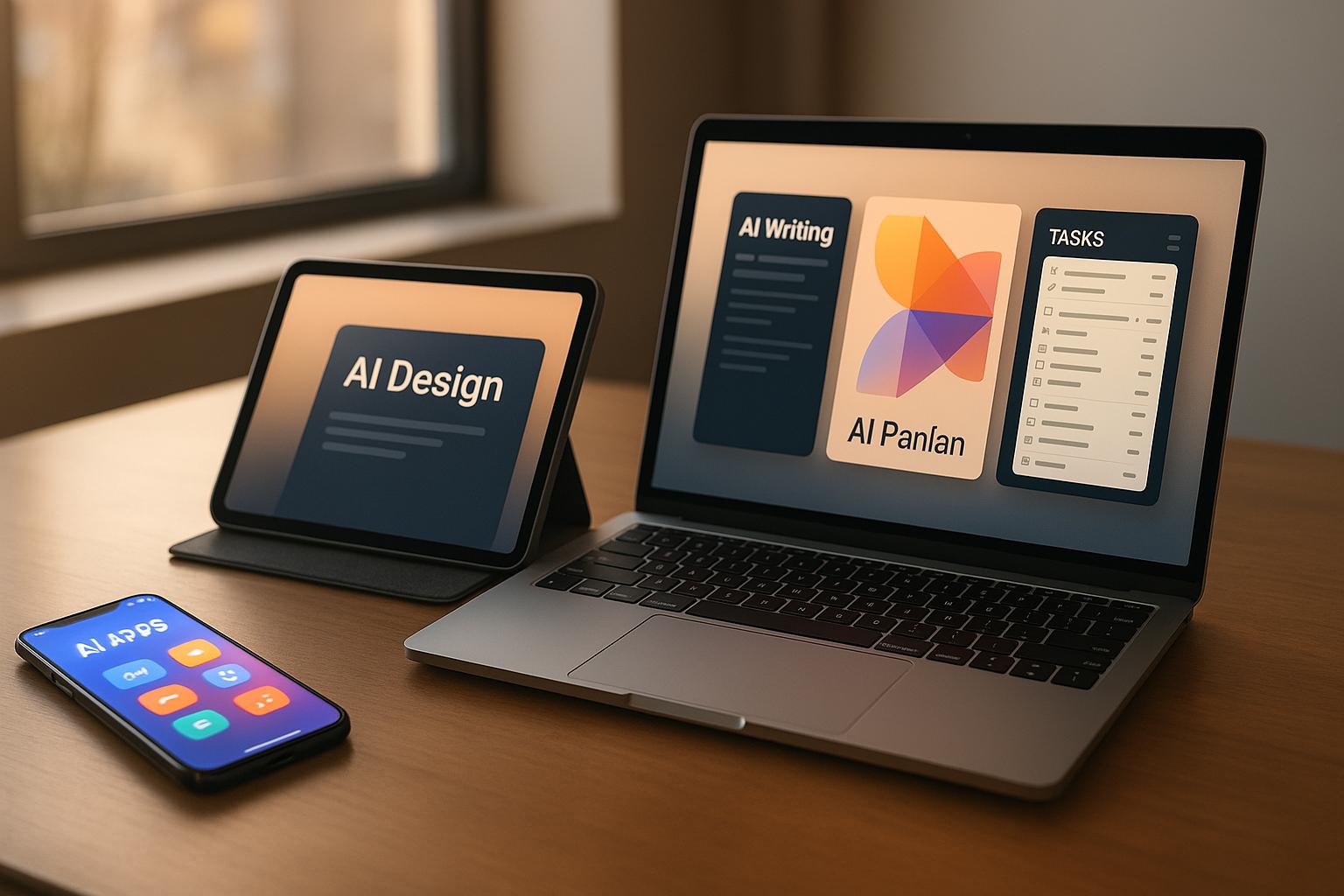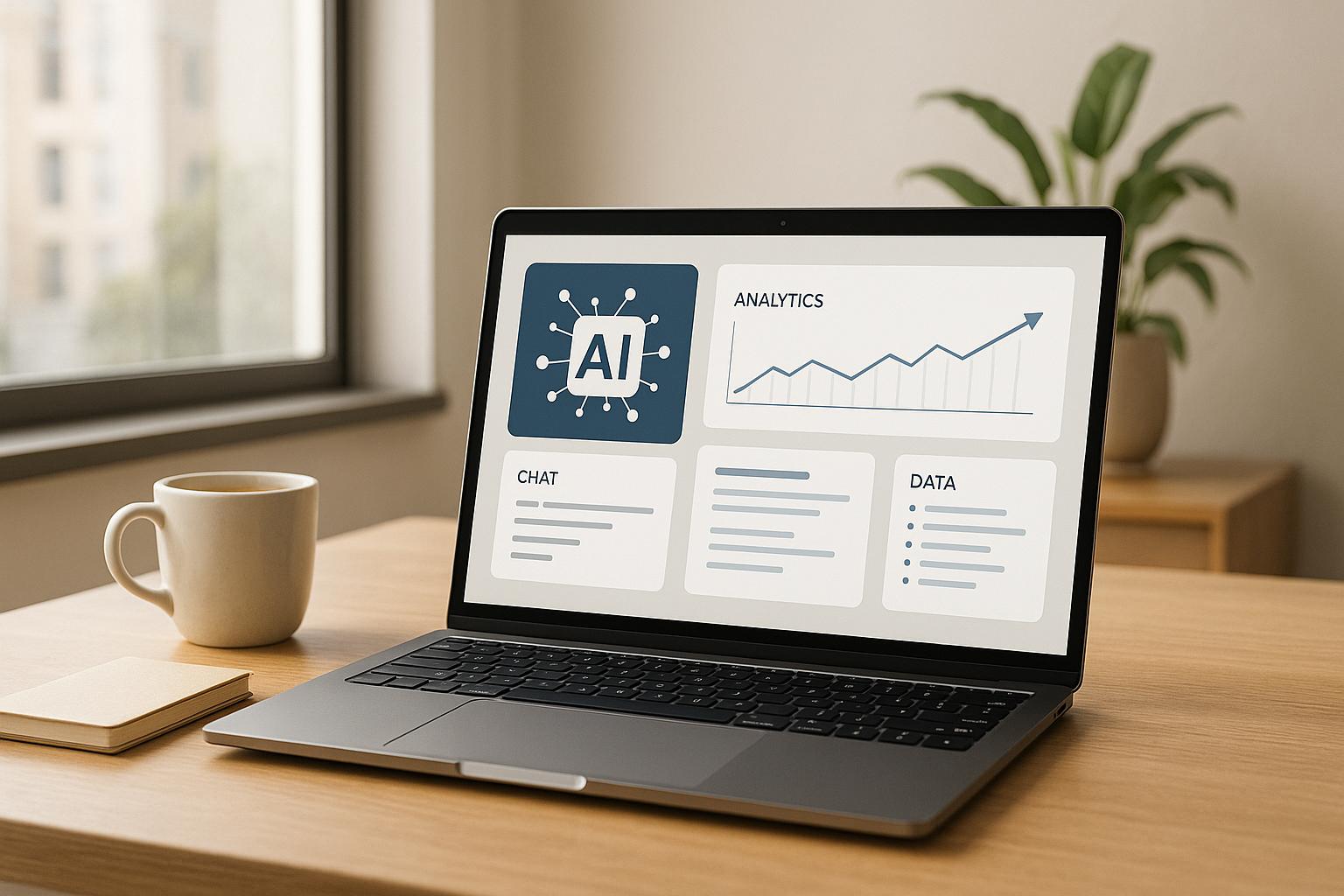Creating an AI chatbot is now incredibly simple - even without coding skills. In just 10 minutes, you can design a chatbot using no-code platforms that offer drag-and-drop tools. Here’s how:
- Pick a Platform: Choose a no-code chatbot builder with features like Natural Language Processing (NLP), visual flow builders, pre-built templates, and integrations with tools like CRMs or email platforms.
- Build Your Chatbot: Use templates or design conversation flows with a drag-and-drop interface. Customize settings like bot name, language, and response style.
- Test and Launch: Test your chatbot for smooth performance on various devices and scenarios. Deploy it on your website or other platforms.
- Track and Improve: Monitor metrics like engagement, fallback rates, and user satisfaction. Use feedback to update responses and improve its performance.
Quick Tip: A well-designed chatbot can reduce customer support costs by 30% and improve sales by 67%. Start building yours today to save time and boost efficiency.
How to Build a FREE AI Chatbot in Less Than 10 Minutes
Step 1: Pick a No-Code Platform
The first step in creating your chatbot in just 10 minutes is selecting a no-code platform that combines user-friendliness with powerful features.
Key Features to Look For
When evaluating no-code platforms, focus on these essential features:
Natural Language Processing (NLP)
Opt for a platform with advanced NLP capabilities to ensure it understands user intent and context accurately.
Visual Flow Builder
A drag-and-drop interface makes it easy to design conversation flows and customize responses, all without writing a single line of code.
Pre-Built Templates
Save time by using templates tailored for specific purposes, such as:
- Customer support
- Lead generation
- Appointment scheduling
- Product recommendations
Integration Options
Check if the platform integrates seamlessly with tools you already use, like:
- CRM systems
- Help desk software
- Email marketing platforms
- E-commerce platforms
- Communication tools such as Slack or Microsoft Teams
Analytics and Reporting
Access insights to measure how well your chatbot performs. Look for metrics such as:
- Conversation volume
- User engagement rates
- Response accuracy
- Customer satisfaction levels
- Overall performance trends
Using AI Apps to Find the Right Tool
To simplify your search, use AI Apps’ directory and filtering options. Here’s how to narrow down your choices:
Define Your Needs
Start by clarifying your chatbot's main purpose. Then, identify the features and integrations that are non-negotiable.
Budget-Friendly Options
Compare free and paid platforms, factoring in long-term costs to find one that fits your budget.
For example, a small retail store adopted a no-code platform for inventory management. By reducing stockouts and overstock issues, they saw a 20% increase in sales due to better product availability.
Finally, ensure the platform supports mobile-friendly design, multi-language functionality, custom branding, proactive chat triggers, and live chat handoff for a complete solution.
Step 2: Build Your Chatbot
Create your chatbot in just 10 minutes, no coding required. Follow these simple steps to get started.
Platform Setup Steps
-
Create Your Account
Sign up for a free account and name your workspace to reflect your chatbot's purpose. -
Configure Basic Settings
Set up the following:- Bot name and avatar
- Default language: English
- Time zone: US
- Response delay: 1-2 seconds
Once these basics are in place, you’re ready to design your chatbot's conversation flows.
Create Chat Flows
Use the drag-and-drop interface to design clear conversation paths. Define specific triggers and responses to guide users effectively.
Welcome Message
Example: "Hi! 👋 I'm [Bot Name], your virtual assistant. How can I help you today?"
Essential Flows
| Flow Type | Purpose | Example Trigger |
|---|---|---|
| FAQ Responses | Answer common questions | "What are your hours?" |
| Lead Collection | Gather contact details | "I'd like to learn more" |
| Support Routing | Direct users to help | "I need assistance" |
Response Types
Offer users a variety of response options to keep interactions engaging:
- Quick reply buttons
- Multiple choice questions
- Open-ended text inputs
- Image carousels for visual options
Once your flows are ready, fine-tune your bot to align with your brand and user expectations.
Adjust Bot Settings
Response Style
Set the response style to a balanced creativity level (temperature 0.2). Enable typing indicators and include a 1-2 second delay to ensure a natural conversational feel.
Handover Rules
Seamlessly transfer users to human support in these scenarios:
- After three failed interaction attempts
- When specific keywords like "speak to human" are detected
- For complex questions that require human input
Design Customization
Match your chatbot to your brand by customizing colors, fonts, and button styles.
sbb-itb-212c9ea
Step 3: Test and Launch
Now that your chatbot is built and tailored to your needs, it’s time to put it through its paces before going live.
Check Bot Responses
Testing is critical to ensure your chatbot delivers reliable and accurate interactions. A poor experience can be a dealbreaker - 73% of consumers won’t give a chatbot a second chance after a bad interaction.
Key Areas to Test
- Conversation Flow: Check if the chatbot handles essential elements like:
- A clear and engaging welcome message
- Easy-to-use navigation buttons
- Quick response times
- Effective fallback options for unrecognized inputs
- Device and Scenario Testing: Test the chatbot on desktops, mobile devices, and various operating systems. Simulate common scenarios - like FAQs, product inquiries, and support requests - and edge cases to ensure smooth and accurate responses.
"ChatBot is really great with customization and scalability. We use it on all of our 13 domains with +800k unique monthly visitors, and personalize the experience depending on the language." - Rasmus Serup, CEO of Hairlust
Add to Your Channels
Once you’re confident in your chatbot’s performance, it’s time to deploy it across your platforms.
Steps for Website Integration
- Go to your platform’s integration section.
- Copy the chatbot code provided by your builder.
- Insert the code into your website's HTML.
- Test and confirm the installation is working properly.
Keep an Eye on Performance
To ensure your chatbot meets expectations, track these metrics after deployment:
- Response accuracy: Are the answers correct and relevant?
- User satisfaction: Are users happy with the interaction?
- Conversation completion rates: How often do users successfully complete their queries?
- Handoff frequency: How often does the chatbot escalate to human support?
| Testing Phase | Key Actions | Success Indicators |
|---|---|---|
| Initial Test | Run through core conversations | All paths function as planned |
| User Testing | Have team members interact | Flows are clear and intuitive |
| Live Testing | Monitor the first 24 hours | Few fallback responses needed |
Interestingly, 40% of consumers don’t mind whether they’re assisted by AI or a human, as long as their issues are resolved quickly and effectively. Use this insight to refine your chatbot based on real-world interactions.
Launch Monitoring
During the first week after launch, pay close attention to:
- How users engage with the chatbot
- The most common conversation paths
- Frequently triggered fallback messages
- Response speed across all integrated channels
This initial monitoring phase is crucial for ironing out any kinks and ensuring the chatbot delivers a seamless experience.
Step 4: Track and Improve
Once your chatbot is live, the work doesn’t stop there. To keep it running smoothly and meeting user needs, you’ll need to continuously monitor its performance and fine-tune its responses.
Measure Performance
Keeping an eye on the right metrics is key to understanding how well your chatbot is performing and where there’s room for improvement.
Key Metrics to Keep an Eye On
Here are some of the most important metrics to track:
- Engagement Rate: This tells you the percentage of users who actively interact with your chatbot after their first contact.
- Goal Completion Rate (GCR): Tracks how often users successfully achieve their desired outcomes.
- Fallback Rate: Measures how often your chatbot fails to understand user inputs, signaling areas that need improvement.
- Average Conversation Length: Provides insight into how long users typically spend interacting with your bot.
- User Satisfaction Score: Collect feedback through post-conversation surveys to gauge user sentiment.
| Metric Type | What to Track | Why It Matters |
|---|---|---|
| Engagement | Total interactions & frequency | Reveals how often users adopt and use the bot. |
| Quality | Goal completion & fallback rates | Highlights how effective the bot is at helping users. |
| Cost | Cost per interaction | Shows return on investment and efficiency. |
Use Customer Input
Your users are one of your best sources of feedback. Their input can help you identify what’s working and what needs improvement.
Dive into Conversation Histories
Reviewing chat logs can uncover valuable insights, such as:
- Frequently asked questions or recurring requests.
- Moments where conversations falter or fail.
- Specific areas where responses could be more accurate or helpful.
Make Smart, Data-Driven Updates
Use the data you collect to make targeted improvements:
-
Polish Response Clarity
Ensure your chatbot communicates clearly by addressing:- Overly technical or complex language.
- The need for clear, step-by-step instructions.
- Simplifying error messages to make them easy to understand.
-
Update the Knowledge Base
Keep your chatbot’s information accurate and relevant by:- Adding new FAQs based on user interactions.
- Updating outdated responses.
- Expanding response variations to better handle different phrasing.
-
Optimize for Different Channels
Evaluate how your chatbot performs across platforms and make adjustments:- Check how well it integrates with your website.
- Ensure it works seamlessly on mobile devices.
- Maintain consistency across all platforms where your chatbot is available.
Conclusion: Your 10-Minute Chatbot Guide
Creating an AI chatbot is easier than ever - no advanced coding skills required. Thanks to modern no-code platforms, you can boost engagement and provide around-the-clock support without breaking a sweat.
The real secret to success? Picking the right platform and sticking to a clear, step-by-step plan. With intuitive drag-and-drop tools, turning your chatbot idea into a functional reality is now within anyone's reach.
Here’s a compelling stat: well-crafted chatbots can cut down email inquiries by more than 80% by efficiently managing routine questions and FAQs. By feeding your chatbot with targeted, relevant data and keeping its knowledge base current, you can transform it from a basic assistant into a specialized expert.
To get the best results, focus on these key strategies:
- Train with purpose: Use specific, relevant data to sharpen your chatbot’s expertise.
- Keep it fresh: Regularly update its knowledge base to ensure accuracy.
- Track and adapt: Monitor user interactions to spot areas for improvement.
- Refine responses: Use feedback to fine-tune how your chatbot communicates.
Launching your chatbot is just the beginning. Ongoing performance tracking and user feedback are essential to keep it aligned with user needs and expectations.
Finally, remember that the AI chatbot landscape is always changing. Staying informed about new trends and practices will help you maximize your chatbot’s potential and keep it delivering value over time.
FAQs
What no-code platforms can I use to create an AI chatbot quickly?
You can use ChatGPT to build an AI chatbot even if you have zero coding skills. These platforms are built with simplicity in mind, making it easy to set up and personalize your chatbot in just a few minutes. Just follow the straightforward steps provided to customize it for your personal or business requirements.
How can I make sure my chatbot understands users and responds accurately?
To make sure your chatbot delivers accurate and helpful responses, start by training it with relevant, high-quality data. This could include resources like business documents, customer FAQs, or transcripts from past interactions. Before using this data, clean it up - remove errors, outdated information, and anything irrelevant. Keeping the formatting consistent will also improve the chatbot’s performance.
Another effective approach is to create sample input-output pairs. These examples teach the chatbot how to handle specific types of queries, giving it a solid foundation to work from. Don’t forget to regularly update its knowledge base with fresh, relevant information. This ongoing maintenance ensures the chatbot stays accurate and continues to meet user needs effectively. Over time, a well-trained and regularly updated chatbot will become a more reliable tool.
How can I track and improve my AI chatbot’s performance after launching it?
To make sure your AI chatbot delivers a strong performance after launch, you’ll need to keep a close watch on how it’s doing and make adjustments based on real user interactions. Pay attention to key areas like user engagement, chatbot success rates, and conversation quality.
Start by tracking user metrics - look at the number of active users and new users to measure growth and engagement. Then, dive into chatbot performance metrics, such as goal completion rates and error rates, to pinpoint where improvements are needed. Don’t overlook user feedback, as it can reveal satisfaction levels and highlight any recurring issues. By regularly analyzing these insights and fine-tuning your chatbot, you can enhance its functionality and deliver a better experience for your users.



